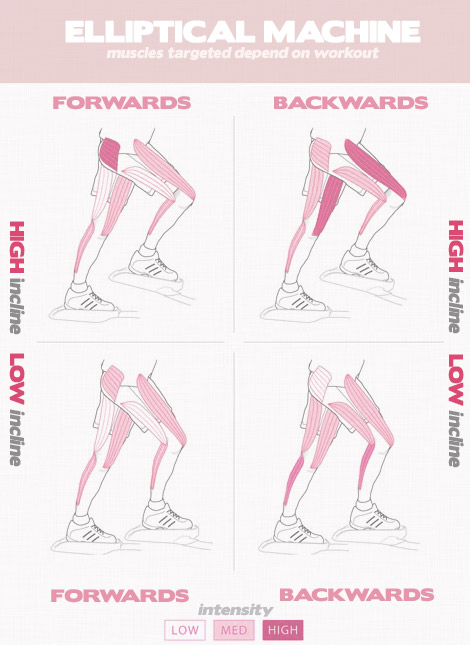The elliptical trainer has many advantages and targets a host of muscle groups in the upper and lower body. To really work these muscles you have to use the elliptical trainer correctly.
1. Elliptical Trainer Posture
- Remember to maintain good posture to get the most out of your workouts.
- Adopt a comfortable standing position with your spine in a neutral position (with a straight back).
- Your hips, knees and ankles should be in alignment.
- Keep your shoulders back, your head up and your abdominal muscles tight.
- Let your lower body support your weight.
- Your weight should be distributed approximately evenly between the heels and the balls of the feet, sitting a little back on your heels.
- Stick your butt out as much as you can. This will target your butt, outer thigh and hamstring muscles and lessen the strain on your quadriceps (thighs).
2. Resistance on Elliptical Trainer
The elliptical trainer is very versatile. You can use the elliptical trainer as a cardio workout, by going fast with little resistance. You can also use the elliptical as a resistance based workout, where you are going slower but working against greater resistance to work and tone your legs. (Read more here for more about targeting specific parts of your body)
If your focus is cardio: Pay attention to your strides per minute (SPM). SPM is the number of times your legs go around. The elliptical trainer shows this number on the screen. If you can try to keep to between 140 and 160 strides per minute. If you are doing interval training on the elliptical trainer, make sure your sprints are closer to 160 strides per minute.
If your focus is toning your thighs: Concentrate on your feet. If you press down with your heels, you will work your hamstrings and bottom more. If you press with your toes, you will tone your quadricep muscles (front of your thighs) more.

3. Work Your Core Muscles on Elliptical Trainer – Hands Free
You can choose not to use the handlebars (you must have good balance) during some of your workout. This strengthens the core muscles, and improves posture and balance. Make sure you don’t sway from side to side once you let go of the handles.
Instead of holding onto handles, try pumping your arms as though you were running. If you are not paying attention to maintaining posture, you will have the natural tendency to move from side to side, instead of propelling forward, when going hands-free. Your hips may move from left to right and although your heart rate remains elevated, your quads are not working as hard as they should be. If this is a problem, to ensure you maintain proper form, place your hands firmly on your hips and pull your shoulder blades together to maintain posture. Your hips move less, your core tightens and your quads are engaged.
For an even greater challenge, transfer weight from heel to toe throughout the workout.
4. Resistance Training on the Elliptical
You can use the elliptical trainer to really target and work your leg muscles and glutes. Do this by increasing the resistance or if a feature on the elliptical trainer by increasing incline.
You can also do incline intervals increasing the angle for a few minutes at a time, followed by a similar period with a lower incline. This will really work your guteal muscles (bottom). You can also do intervals with high and low resistance. Intervals make a great combination of cardio and resistance workouts.
The elliptical can give you amazingly toned thighs, if you use the elliptical several times a week with high resistance. Once you are happy with your legs as they are, keep the resistance/ incline constant.
5. Do You Have a Body Part In Mind?
When you get on the elliptical trainer, you may have a particular body part in mind that you want to tone. Some of the newer elliptical trainers have body-part specific pre-set programs, such as “gluteal training” or one targeting the calf muscles. Choose the program that you want.

